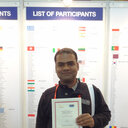Possible nitric oxide mechanism in the protective effect of hesperidin against pentylenetetrazole (PTZ)-induced kindling and associated cognitive dysfunction in mice.
Ключавыя словы
Рэферат
Epilepsy is a complex neurological disorder manifested by recurrent episodes of convulsive seizures, loss of consciousness, and sensory disturbances. Pentylenetetrazole (PTZ)-induced kindling primarily represents a model of generalized epilepsy. The present study has been undertaken to evaluate the neuroprotective potential of hesperidin and its interaction with nitric oxide modulators against PTZ-induced kindling and associated cognitive dysfunction in mice. The experimental protocol comprised of eleven groups (n=6), where a subconvulsive dose of PTZ (40 mg/kg, i.p.) had been administered every other day for a period of 12 days, and seizure episodes were noted after each PTZ injection over a period of 30 min. The memory performance tests were carried out on days 13 and 14 followed by the estimation of biochemical and mitochondrial parameters. Chronic administration of a subconvulsive dose of PTZ resulted in an increase in convulsive activity culminating in generalized clonic-tonic seizures, as revealed by a progressive increase in seizure score as well as alteration in antioxidant enzyme levels (lipid peroxidation, nitrite, glutathione, super oxide dismutase, and catalase) and mitochondrial complex (I, II, and IV) activities, whereas chronic treatment with hesperidin (200 mg/kg) significantly attenuated these behavioral, biochemical, and mitochondrial alterations. Further, treatment with l-arginine (100 mg/kg) or l-NAME (10 mg/kg) in combination with hesperidin significantly modulated the protective effect of hesperidin which was significant as compared to their effects per se in PTZ-treated animals. Thus, the present study suggests a possible involvement of the NO-cGMP pathway in the neuroprotective effect of hesperidin in PTZ-kindled mice.



